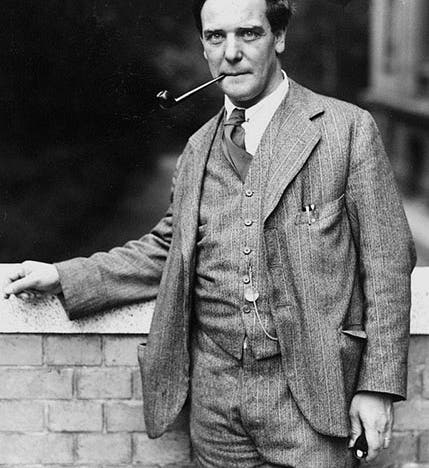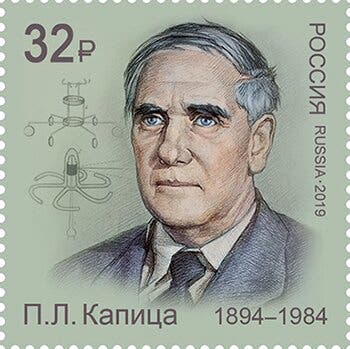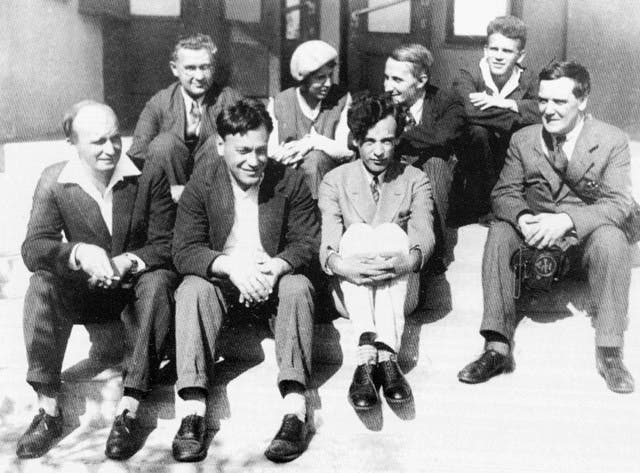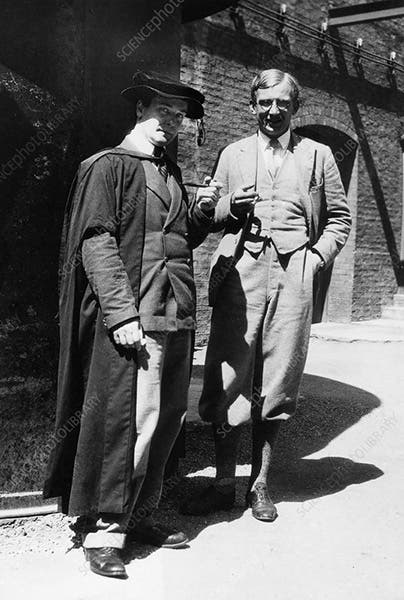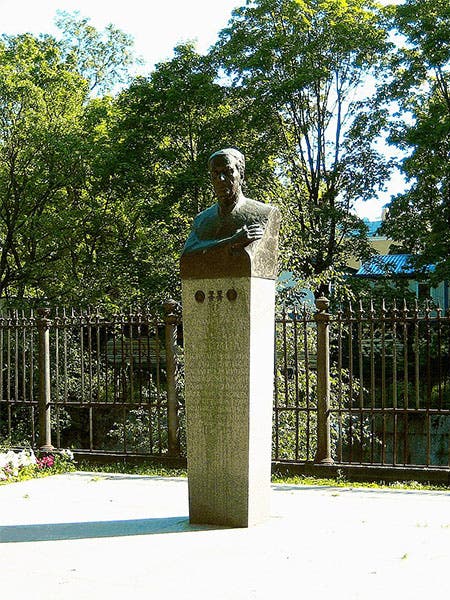Scientist of the Day - Pyotr Kapitsa
Pyotr Kapitsa, a Russian physicist, died Apr. 8, 1984, at the age of 90. After working his way through Russian technical schools with distinction, Kapitsa spent ten years at the Cavendish Laboratory at Cambridge University, 1919-29, working with such distinguished physicists as Ernest Rutherford and up-and-comers like James Chadwick, although he often went back to Russia to attend seminars and give lectures. In 1931, he was appointed the head of the Mond Laboratory at Cambridge, where he turned from the study of high-intensity magnetic fields to low-temperature physics. We show above a photo of Kapitsa taken in the early 1930s, with his ever-present long-stemmed pipe.
Kapitsa attracted the interest of a young Canadian physicist working at Caltech, Jack Allen, who decided to come to the Mond in 1935 to work with Kapitsa on the properties of super-cooled helium. Unfortunately, Kapitsa returned home to Mother Russia in 1934 for a visit, and, his scientific talents being recognized by Russian authorities, he was denied permission to return to Cambridge. Kapitsa instead was given a scientific institute of his own to run in Moscow, the Institute of Physical Problems, founded in 1934 (and now the Kapitsa Institute). Consequently, Kapitsa and Allen worked separately on the behavior of liquid helium. In 1937, Kapitsa discovered superfluidity in liquid helium, which is different from the more familiar super-conductivity. Superfluid liquids have zero viscosity, so eddies within them can swirl forever, and liquid helium can even climb up and out of a container in its viscous-free state. What makes the discovery of superfluidity especially interesting is that Jack Allen, working back in Cambridge, independently made exactly the same discovery, at about the same time in 1937. Indeed, their two papers were published right next to each other in Nature in January of 1938. Kapitsa would eventually (1978) share a Nobel prize "for his basic inventions and discoveries in the area of low-temperature physics". However, he did not share it with Allen, who never did get a piece of a prize, but with Arno Penzias and Robert Wilson, who discovered the cosmic background radiation in 1965. Perhaps because both discoveries involved low temperatures (the cosmic background radiation corresponded to a temperature of 3 degrees above absolute zero), the Nobel committee thought they had something in common, but they were not at all related. It was a very strange Nobel award.
Kapitsa was not an active dissenter during the Great Purge of 1937-38 in Russia, but when his colleague Lev Landau, another brilliant physicist, was arrested with two fellow physicists in 1938 and charged with being a German spy, Kapitsa wrote a strong letter in protest and testified at a tribunal, pointing out that it was highly unlikely that a Russian Jew, as Landau was, would work for the Germans. Landau was released after a year in confinement, which was 19 years sooner than his two colleagues. There is a photo that shows Landau and Kapitsa together in 1934 (third image, above); Landau is in the front row, second from the right, and Kapitsa is right next to him, far right. When Lavrentiy Beria, the head of the NKVD, was given control of the Soviet atomic bomb project in late 1944, Kapitsa wrote several letters of protest directly to Stalin, arguing that such a position should be filled by a physicist and that Beria was not competent to be in charge of the project. Not many people went up against Beria and walked away, but Kapitsa did, this time. Later, after the War, he would pay the price, when he was removed from his directorship at the Institute. However, he never lost his reputation as one of the most distinguished Soviet physicists, and he has been on a number of Russian stamps, including the one above (second image) issued in 1994 on the centennial of his birth.
We conclude on a lighter note by passing along a delightful story told by the great Russian/American physicist George Gamow, who studied with Kapitsa at Cambridge and can be seen with Kapitsa in a photo taken about 1931 (fourth image, just above); Kapitsa is on the left, in ceremonial garb; the dapper Gamow is at right. The story is about Kapitsa's father-in-law, a Russian mathematician and former Admiral in the Russian Navy, for whom Gamow worked for several years before emigrating to the United States. The Admiral told Gamow that he had calculated the distance to God. In 1905, during the Russo-Japanese War, all Russians were instructed by the Mother Church to pray for retribution against Japan. The Great Earthquake of 1923 struck Japan 18 years later. Assuming that prayers travel at the speed of light, then it is pretty evident, the Admiral argued, that God is about 9 light-years away. Gamow tells the story, and several others involving Kapitsa, in his charming autobiography, My World Line (1970).
Kapitsa is buried in Novodevichye Cemetery in Moscow. Since his memorial stone is rather plain (see it here), we show instead a statue of Kapitsa that was erected after his death in Saint Petersburg (fifth image, just above).
Dr. William B. Ashworth, Jr., Consultant for the History of Science, Linda Hall Library and Associate Professor emeritus, Department of History, University of Missouri-Kansas City. Comments or corrections are welcome; please direct to ashworthw@umkc.edu.

